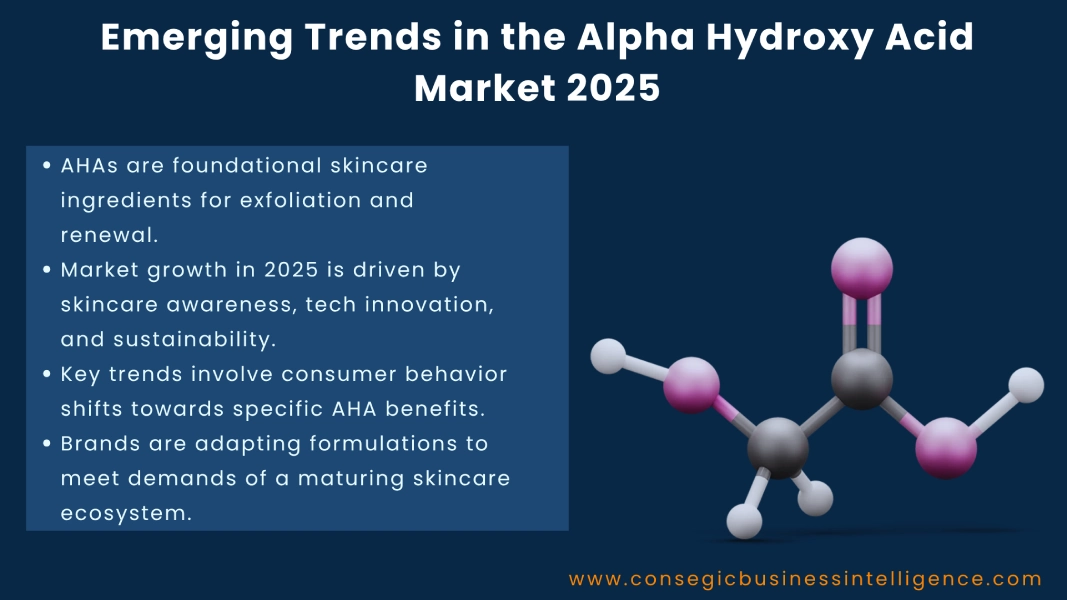Emerging Trends in the Alpha Hydroxy Acid Market 2025
Alpha Hydroxy Acids (AHAs) have long been a cornerstone of skincare, essential for their ability to exfoliate, brighten, and renew the cells of the skin. These acids are generally sourced from fruits and milk, and usually consist of a wide class of acids such as glycolic, lactic, citric, and mandelic acids, entirely transforming the skincare regime. Fueling the growth, 2025 has presented significant opportunities for the AHA market due to the growing awareness of skincare, resulting in shifted consumer behavior, innovations in technology, and a growing emphasis on sustainability.
This blog highlights the emerging trends shaping the alpha hydroxy acids market in 2025, focusing on the directions brands, consumers, and formulators are taking to meet the demands of a rapidly maturing skincare ecosystem.

- Increasing recognition of the natural and sustainable sourcing of AHAs
An advantageous factor for AHAs to gain momentum is the shifting consumer preferences for natural and sustainably sourced ingredients. Consumers extensively rely on plant-derived and organic alternatives to replace artificially produced compounds. For instance, sugarcane is a sustainable and affordable source of glycolic acid, whereas citric acid can be obtained from citrus fruits. In addition to this, skincare brands focus on recomposing formulations to meet the industry standards and integrating eco-friendly and biodegradable packaging.
- Demand for personalizations and customized skincare regimens.
Personalized skincare helps consumers experience effects faster, avoiding skin damage and side effects of the product on the skin. These customized products are tailored to suit the user’s skin types, the sensitivity range of the skin, and other factors. This is easily achieved with the advent of AI and technologies like sensors and cameras to study and analyze the skin and provide better-suited formulations. These formulations customized the quantity and requirement of AHA, peptides, niacinamide, and other ingredients, and offer the perfect serum specifically tailored for the skin.
- Promoting growth in body and scalp care categories.
2025 has witnessed a paradigm shift from the application of AHA for facial skincare to its use across the body and scalp. Products for exfoliating the body, like lotions, hand and foot creams, and lactic acid deodorants, have emerged as efficient AHA products for body care. Moreover, taking care of the scalp is equally important. Incorporating AHAs such as lactic acid and malic acid into shampoos, conditioners, hair masks, and scalp serums aids in removing dead skin cell accumulation and fosters healthier hair growth.
- Expanding hybridization of formulations and AHA-active synergies.
Market growth has accelerated owing to the emergence of new hybrid forms featuring AHAs. Combinations of these exfoliating acids with complementary actives provide added benefits in a single product. AHAs are frequently combined with antioxidants, hyaluronic acid, retinol, and ceramides. These formulations provide multiple benefits in just one application, making it an all-rounder product for a number of skin concerns. Moreover, polyhydroxy acids (PHAs), an upcoming class of gentle exfoliants, and usually combined with AHAs to serve users with sensitive skin types, channeling significant product development, fueling market growth.
- Dermatologists recommended and clinically proven formulations
Consumers expect skincare brands to deliver products that are clinically proven and validated by dermatologists to gain their trust in the brand. This has surged the demand for dermatologist-developed AHA formulations, tested and trialed. Skincare brands specifically focusing on prescription-based AHA products for the treatment of skin-related problems such as melasma, hyperpigmentation, and photoaging, benefit from this trend. Brands are now adapting to the growing base of educated consumers, who refuse to compromise on their health and overall well-being. This entails informing users about the ingredients via ingredient labels on the packaging to foster trust and transparency with them.
- Growth of the men’s grooming market.
The rising demand for men’s skincare and grooming has significantly fueled the growth of AHA-based products. The growing number of men turning towards exfoliants to combat ingrown hair, dull skin, and uneven pigmentation of the skin, which can be cured effectively through AHAs. Skincare products like toners, aftershaves, and moisturizers suiting men’s skin requirements have gained traction for some time now. Brands have started creating ads portraying these products as functional and efficient, in the way many male consumers approach skincare. This trend will continue to grow, attracting men from all skin types and ethnicities.
- Influence of digital marketing
Dermatology and skincare have diverted their methods from boring, medicine-looking packaging to taking over social media platforms to innovatively educate people about the benefits of skincare through their ads. Recruiting popular content creators, dermatologists, and skincare influencers to promote ingredient literacy and usage guidelines is the most common method. This influences everyone from normal individuals to skincare enthusiasts and younger users. Such collaborations and branding help the brand gain customers while educating and being transparent on social media.
Conclusion:
The Alpha Hydroxy Acid market in 2025 is experiencing a transformative shift influenced by the shifting consumer expectations, scientific breakthroughs, and changing global trends. AHAs have emerged as versatile chemicals widely accepted across age groups, genders, and demographics, creating significant opportunities for brands to lead this rapidly growing market with innovative and industry-forward skincare products.
